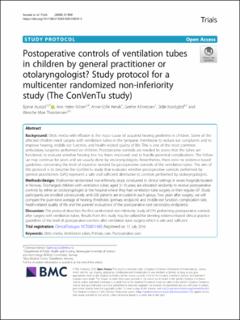| dc.contributor.author | Austad, Bjarne | |
| dc.contributor.author | Nilsen, Ann Helen | |
| dc.contributor.author | Helvik, Anne-Sofie | |
| dc.contributor.author | Albrektsen, Grethe | |
| dc.contributor.author | Nordgård, Ståle | |
| dc.contributor.author | Thorstensen, Wenche Moe | |
| dc.date.accessioned | 2021-04-16T12:29:01Z | |
| dc.date.available | 2021-04-16T12:29:01Z | |
| dc.date.created | 2020-11-29T11:44:18Z | |
| dc.date.issued | 2020 | |
| dc.identifier.issn | 1745-6215 | |
| dc.identifier.uri | https://hdl.handle.net/11250/2738162 | |
| dc.description.abstract | Background Otitis media with effusion is the major cause of acquired hearing problems in children. Some of the affected children need surgery with ventilation tubes in the tympanic membrane to reduce ear complaints and to improve hearing, middle ear function, and health-related quality of life. This is one of the most common ambulatory surgeries performed on children. Postoperative controls are needed to assess that the tubes are functional, to evaluate whether hearing loss has been improved, and to handle potential complications. The follow-up may continue for years and are usually done by otolaryngologists. Nevertheless, there exist no evidence-based guidelines concerning the level of expertise needed for postoperative controls of the ventilation tubes. The aim of this protocol is to describe the ConVenTu study that evaluates whether postoperative controls performed by general practitioners (GPs) represent a safe and sufficient alternative to controls performed by otolaryngologists. Methods/design Multicenter randomized non-inferiority study conducted in clinical settings in seven hospitals located in Norway. Discharged children with ventilation tubes, aged 3–10 years, are allocated randomly to receive postoperative controls by either an otolaryngologist at the hospital where they had ventilation tube surgery or their regular GP. Study participants are enrolled consecutively until 200 patients are included in each group. Two years after surgery, we will compare the pure tone average of hearing thresholds (primary endpoint) and middle ear function, complication rate, health-related quality of life and the parents’ evaluations of the postoperative care (secondary endpoints). Discussion This protocol describes the first randomized non-inferiority study of GPs performing postoperative controls after surgery with ventilation tubes. Results from this study may be utilized for deriving evidence-based clinical practice guidelines of the level of postoperative controls after ventilation tube surgery which is safe and sufficient. | en_US |
| dc.language.iso | eng | en_US |
| dc.publisher | BMC | en_US |
| dc.rights | Navngivelse 4.0 Internasjonal | * |
| dc.rights.uri | http://creativecommons.org/licenses/by/4.0/deed.no | * |
| dc.title | Postoperative controls of ventilation tubes in children by general practitioner or otolaryngologist? Study protocol for a multicenter randomized non-inferiority study (The ConVenTu study) | en_US |
| dc.type | Peer reviewed | en_US |
| dc.type | Journal article | en_US |
| dc.description.version | publishedVersion | en_US |
| dc.source.volume | 21 | en_US |
| dc.source.journal | Trials | en_US |
| dc.identifier.doi | https://doi.org/10.1186/s13063-020-04849-3 | |
| dc.identifier.cristin | 1853744 | |
| dc.relation.project | Samarbeidsorganet mellom Helse Midt-Norge og NTNU: . | en_US |
| cristin.ispublished | true | |
| cristin.fulltext | original | |
| cristin.qualitycode | 1 | |

